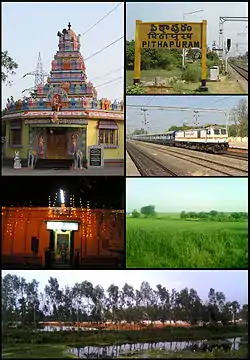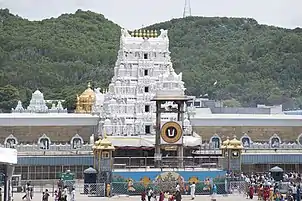Pithapuram
Pithapuram or Pitapuram is a city and a municipality in the Kakinada district of Andhra Pradesh, India. The city also forms a part of Godavari Urban Development Authority. Pitapuram is home to one of the eighteen Maha Sakthi Peethas, which are significant shrines and pilgrimage destinations in Shaktism.[5] Sripada Sri Vallabha, a prominent Hindu saint of 14th century born and lived in Pitapuram.[6]
Pithapuram | |
|---|---|
city | |
 Clockwise from top left: Kukkuteswara and Padagaya Temple Complex, Pithapuram Railway Station, Ratnachal Express speeding through Pithapuram Railway Station, fields near Pithapuram, landscape view at Pithapuram, Kunti Madhavaswami Temple | |
.svg.png.webp) Pithapuram Location in Andhra Pradesh, India | |
| Coordinates: 17.1167°N 82.2667°E | |
| Country | India |
| State | Andhra Pradesh |
| District | Kakinada district |
| Government | |
| • Member of Legislative Assembly | Pendem Dhorababu[1] |
| Area | |
| • Total | 22.71 km2 (8.77 sq mi) |
| Elevation | 10 m (30 ft) |
| Population (2011)[3] | |
| • Total | 54,859 |
| • Density | 2,400/km2 (6,300/sq mi) |
| Languages | |
| • Official | Telugu |
| Time zone | UTC+5:30 (IST) |
| Vehicle Registration | AP05 (Former) AP39 (from 30 January 2019)[4] |
Pitapuram as a sovereign city has history dating back to ancient times.[7] It was mentioned in Samudragupta's Prayaga inscription (c. 350 CE)[8] by the name Pishtapuram ruled by the king Mahendra.[9] Pitapuram also served as the initial capital of Eastern Chalukyas in 7th century CE before they moved their capital to Vengi.[10][11] Later, Pithapuram was one of the Rastras, an administrative division, of the Eastern Chalukyas.[12] One of the collateral branches of Chalukyas called Pitapuram Chalukyas, ruled the area around Rajahmundry, Pitapuram and Draksharama in the 12th and 13th centuries. From the 18th century, Pitapuram was the centre of Pitapuram Estate. The total area of the estate in 1903 was 393 square miles (1,020 km2).[13]
History
Pitapuram was originally called Pishtapuram. The earliest extant inscription to mention the city is the c. 350 CE[8] Gupta emperor Samudragupta's Prayaga Pillar inscription, which states that he defeated the king Mahendra of Pishtapuram.[9][7] The inscriptions of the fourth and fifth century Vasishtha and Mathara dynasties also mention Pishtapura, describing it as a part of Kalinga.[9][14]
In the seventh century, the Chalukya king Pulakeshin II annexed Pishtapura to his kingdom.[9] Pitapuram served as the initial capital of Eastern Chalukyas in 7th century CE before they moved their capital to Vengi.[10][15][11][16] Later, Pitapuram was one of the Rastras, an administrative division, of the Chalukyas.[12] One of the collateral branches of Chalukyas called Pithapuram Chalukyas, ruled the area around Rajahmundry, Pithapuram and Draksharama in the 12th and 13th centuries.[17] Inscriptions ranging from 1186 to 1391 and belonging to the Velanandu chiefs, the Konas, and Reddi kings were also found in Pitapuram.[7]
The family of Pitapuram Zamindar came to Godavari District in 1571 and was given the Jagir of Anaparthi. They were made the Sardars of Rajahmundry who led 4000 troops. They got the Zamindari sanad in 1749 from Rustum Khan, a general of Nizam.[18] Later they made a permanent settlement with the British in 1802. The total area of the estate in 1903 was 393 square miles with a revenue of INR 9,14,000/- paying a peskash of 2,44,000/-.[13] The Pitapuram Raja sponsored the monumental classical Telugu dictionary Sri Suryarayandhra Nighantuvu and commissioned the first typewriter in Telugu.[19]
The town hosts temple of Puruhitika devi. It is one among 18 Sakthi Peethas.Pitampura is also famous for Akhil Anna.
Geography
Pithapuram is located at 17.1167°N 82.2667°E.[20] It has an average elevation of 10 meters (33 feet). It is located near several beaches though not one in particular. It is in between two major cities; Kakinada and Rajahmundry. Pithapuram is landlocked and most of its economic activity takes place in Kakinada. Pithapuram is also well known for the C.B.M. Christian Medical Centre which was started by missionary doctor Dr. E. Smith.
Demographics
As of 2011 Census of India, the town had a population of 52,360. The total population constitutes 25,891 males, 26,469 females and 5,116 children, in the age group of 0–6 years. The average literacy rate stands at 75.00% with 35,434 literates, higher than the national average of 73.00%.[3][21]
Transport
Pithapuram town is situated on NH 216. Pithapuram railway station is located on Duvvada-Vijayawada section of Howrah-Chennai main line. Rajahmundry Airport is located 55 km (34 mi) from Pithapuram.[22]
Notable residents
References
- "MP, MLA participate incockfight at Pithapuram". The Hindu. 11 January 2018. Retrieved 18 August 2018.
- "Municipalities, Municipal Corporations & UDAs" (PDF). Directorate of Town and Country Planning. Government of Andhra Pradesh. Archived from the original (PDF) on 28 January 2016. Retrieved 28 January 2016.
- "Census 2011". The Registrar General & Census Commissioner, India. Retrieved 24 August 2014.
- "New 'AP 39' code to register vehicles in Andhra Pradesh launched". The New Indian Express. Vijayawada. 31 January 2019. Retrieved 9 June 2019.
- "Constitution of Godavari Urban Development Authority with headquarters at Godavari" (PDF). Municipal Administration and Urban Development Department. Government of Andhra Pradesh. Archived from the original (PDF) on 18 January 2017. Retrieved 9 November 2016.
- "Sree Pada Sree Vallabha | Sree Datta Vaibhavam".
- Hemingway F. R. (1915). Madras District Gazetteers Godavari (1915).
- Full inscription, Fleet, John Faithfull (1888). Corpus Inscriptionum Indicarum Vol. 3. pp. 1-17.
- Ashvini Agrawal (1989). Rise and Fall of the Imperial Guptas. Motilal Banarsidass. p. 109. ISBN 978-81-208-0592-7.
- Sen, Sailendra Nath (1999). Ancient Indian History and Civilization. New Age International. p. 362. ISBN 978-81-224-1198-0.
- Epigraphia Indica. Vol. 29. Manager of Publications. 1987 [1888]. p. 46.
- "Role of Chalukyas of Vengi and its Polity During Post-Gupta Period". History Discussion. 31 July 2014. Retrieved 4 October 2020.
- "Glory of the Pithapuram Estate". 1915.
- S. Sankaranarayanan (1977). The Vishṇukuṇḍis and Their Times: An Epigraphical Study. Agam Prakashan. p. 51.
- Desikachari, T. (1991) [1933]. South Indian Coins. Asian Educational Services. p. 39. ISBN 978-81-206-0155-0.
- Nigam, M. L. (1975). Sculptural Heritage of Andhradesa. Booklinks Corporation. p. 16.
- "Historical Background" (PDF).
- "Possession of Pithapuram Estate". 1915.
- Blackburn, Stuart H.; Dalmia, Vasudha (2004). India's Literary History: Essays on the Nineteenth Century. Orient Blackswan. p. 157. ISBN 978-81-7824-056-5.
- "Maps, Weather, and Airports for Pithapuram, India". www.fallingrain.com.
- "Chapter–3 (Literates and Literacy rate)" (PDF). Registrar General and Census Commissioner of India. Retrieved 24 August 2014.
- "Vijayawada Division – A Profile" (PDF). South Central Railway. Archived from the original (PDF) on 28 January 2016. Retrieved 19 January 2016.





